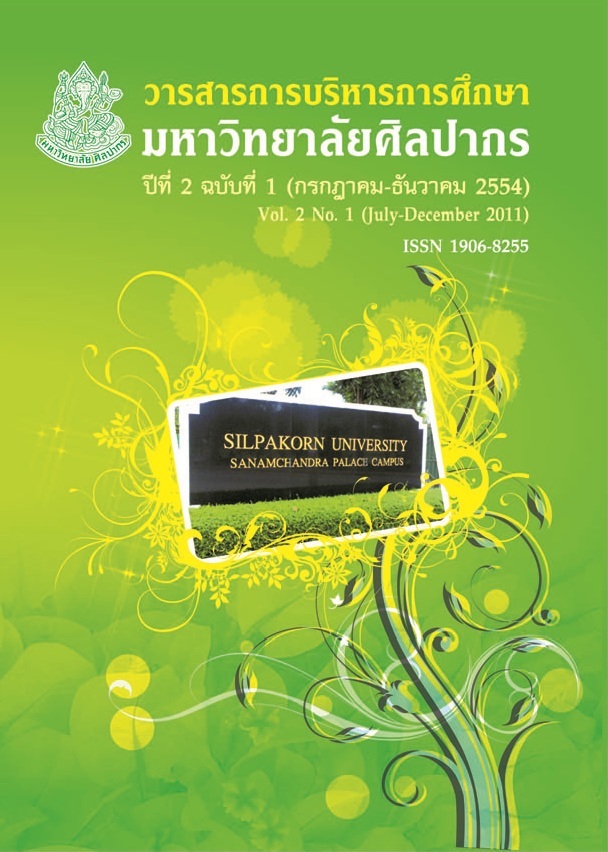การมีส่วนร่วมของผู้ที่อยู่อาศัยในท้องถิ่นในการจัดการศึกษาของไทย ในรัชสมัยพระบาทสมเด็จพระปรมินทรมหาภูมิพลอดุลยเดช
คำสำคัญ:
การจัดการศึกษา, การมีส่วนร่วม, ผู้ที่อยู่อาศัยในท้องถิ่น, Educational management, Local residents, Participationบทคัดย่อ
การวิจัยนี้มีวัตถุประสงค์สำคัญเพื่อ 1) ค้นหาและวิเคราะห์สภาพการมีส่วนร่วมของผู้ที่อยู่อาศัยในท้องถิ่นในการจัดการศึกษาของไทย 2) นำเสนอแนวโน้มการมีส่วนร่วมของผู้ที่อยู่อาศัยในท้องถิ่นในการจัดการศึกษาของไทยในอนาคต และ 3) สังเคราะห์ข้อเสนอเชิงนโยบายการส่งเสริมการมีส่วนร่วมของผู้ที่อยู่อาศัยในท้องถิ่นในการจัดการศึกษาของไทย
การศึกษาจำแนกได้เป็น 3 ระยะ ดังนี้ ระยะที่ 1 เป็นการศึกษาสภาพการมีส่วนร่วมของประชาชน ข้อมูลการวิจัยได้มาจากเอกสารชั้นต้น และเอกสารชั้นรอง จากแหล่งข้อมูล หอสมุด หน่วยงานต่างๆ และฐานข้อมูลอิเล็กทรอนิกส์เครื่องมือการวิจัย ประกอบด้วย แบบประเมินคุณภาพเอกสาร แบบประเมินงานวิจัย และแบบบันทึกข้อมูล เก็บรวบรวมข้อมูลโดยการสืบค้น เอกสาร คัดเลือกเอกสาร และประเมินเอกสาร วิเคราะห์ข้อมูลด้วยวิธีการวิเคราะห์เนื้อหา การศึกษาระยะที่ 2-3 เพื่อนำเสนอแนวโน้มและข้อเสนอเชิงนโยบาย ผู้วิจัยได้จัดทำเอกสารฉบับร่าง และดำเนินการสนทนากลุ่มผู้เชี่ยวชาญ จำนวน 13 คน เพื่อประเมินด้านความครอบคลุม ความเหมาะสม ความสอดคล้อง ความชัดเจน ความมีประโยชน์ และความเป็นไปได้ และจัดทำเป็นเอกสารฉบับสมบูรณ์
ผลการวิจัยสรุปได้ว่า 1) ผู้ที่อยู่อาศัยในท้องถิ่นทุกกลุ่มมีส่วนร่วมในการจัดการศึกษา ได้แก่ กลุ่มพ่อแม่-ผู้ปกครองกลุ่มนักเรียน-ศิษย์เก่า กลุ่มเอกชน และชุมชน เรื่องที่มีส่วนร่วมครอบคลุมใน 7 ประเด็น คือ (ก) การจัดตั้งสถานศึกษา (ข) หลักสูตรและการเรียนการสอน (ค) การบริหารการศึกษา (ง) มาตรฐานและการประกันคุณภาพการศึกษา (จ) ครูและบุคลากรทางการศึกษา (ฉ) ทรัพยากรและการลงทุนเพื่อการศึกษา และ (ช) สื่อ เทคโนโลยีและแหล่งการเรียนรู้ทั้งในช่วงปี พ.ศ.2489-2541 และช่วงปี พ.ศ.2542-2554 ผู้ที่อยู่อาศัยในท้องถิ่นมีส่วนร่วมมากในเรื่องการจัดตั้งโรงเรียนและเรื่องหลักสูตรและการเรียนการสอน ส่วนวิธีการมีส่วนร่วมในช่วงปี พ.ศ.2489-2541 เป็นการร่วมดำเนินการแบบเชิงรับ ในลักษณะของการบริจาคทรัพย์สินและแรงงาน ส่วนในช่วงปี พ.ศ.2542-2554 เป็นแบบเชิงรุก โดยการร่วมคิดตัดสินใจ และร่วมดำเนินการมากขึ้น 2) แนวโน้มการมีส่วนร่วมของผู้ที่อยู่อาศัยในท้องถิ่นในการจัดการศึกษาของไทยมีการเปลี่ยนแปลงสอดรับกับความก้าวหน้าทางเทคโนโลยีสารสนเทศเป็นหลัก โดยการมีส่วนร่วมครบทั้งกระบวนการ คือ การร่วมคิด ตัดสินใจ ร่วมดำเนินการ ร่วมรับผลที่เกิดขึ้น และร่วมประเมินผล 3) ข้อเสนอเชิงนโยบายการส่งเสริมการมีส่วนร่วมของประชาชนในการจัดการศึกษาของไทย ประกอบด้วย (ก) การจัดระบบและกลไกในการพัฒนาการมีส่วนร่วมในการจัดการศึกษาให้มีคุณภาพ(ข)การพัฒนาระบบการบริหารจัดการการมีส่วนร่วมในการจัดการศึกษาให้มีประสิทธิภาพ (ค) การจัดระบบส่งเสริมสนับสนุนให้เกิดการมีส่วนร่วมเชิงรุกในทุกขั้นตอนอย่างแท้จริงโดยเฉพาะการมีส่วนร่วมรับผลและร่วมประเมินผล และ (ง) การจัดระบบเสริมสร้างแรงจูงใจ ขวัญกำลังใจในการมีส่วนร่วมจัดการศึกษาให้กับผู้ที่อยู่อาศัยในท้องถิ่น
LOCAL RESIDENTS PARTICIPATION IN THAI EDUCATIONAL MANAGEMENT DURING THE REIGN OF HIS MAJESTY KING BHUMIBOL ADULYADEJ
The objectives of this research were 1) to investigate and analyze the state of local residents participation in Thai educational management; 2) to point out the future trend of local residents participation; and 3) to synthesize the policy proposals on promotion of local residents participation.
In Phases I and II of this study, the research information was obtained from primary and secondary documentary sources from libraries, work agencies, and electronic databases. Research instruments comprised a document/research quality evaluation form and an information recording form. The methods of data collection were document searches, document selection and document evaluation. The data analysis method was content analysis. Phase III of the study started with the drafting of the trend of people participation in educational management and policy recommendations to promote people participation in educational management in Thailand. After that, a focus group discussion involving 13 experts was conducted to evaluate the coverage, appropriateness, relevancy, clarity, usefulness and feasibility of the policy recommendations.
The research findings can be concluded as follows: 1) All groups of local residents participated in educational management in Thailand including parent and guardians, students and alumni, communities, and private sector. The participation covered seven following points: (a) school establishment; (b) curriculum and instruction; (c) educational administration; (d) educational standards and quality assurance; (e) teachers and education personnel; (f) resources and investment in education; and (g) educational media, technology, and learning sources. During B.E. 2489 – 2541 (A.D. 1946 – 1998) and B.E. 2542 – 2554 (A.D. 1999 – 2011), the local residents participated at the high level in school establishment, and curriculum and teaching-learning process. The participation method during B.E. 2489 – 2541 was that of responsive participation in terms of donation of properties and labors; while the participation method during B.E. 2542 – 2554 was that of active participation in terms of participating more in thinking and decision making, and implementation. 2) The future trend of people participation in educational management in Thailand would be mainly in line with the progress in information technology resulting in the whole process of participation, i.e. participation in thinking and decision making, implementation, taking benefits, and participation in evaluation. 3) The policy recommendations on promotion of local residents participation in educational management in Thailand were as follows: (a) the establishment of system and mechanism for development of people participation in educational management to achieve educational quality; (b) the development of an effective system for management of efficient participation in educational management; (c) the establishment of supporting and promotion system to facilitate actual proactive participation in every step, especially the participation in benefits and in evaluation; and (d) the establishment of a system for enhancement of incentives and morale of the people to promote more participation in educational management.




